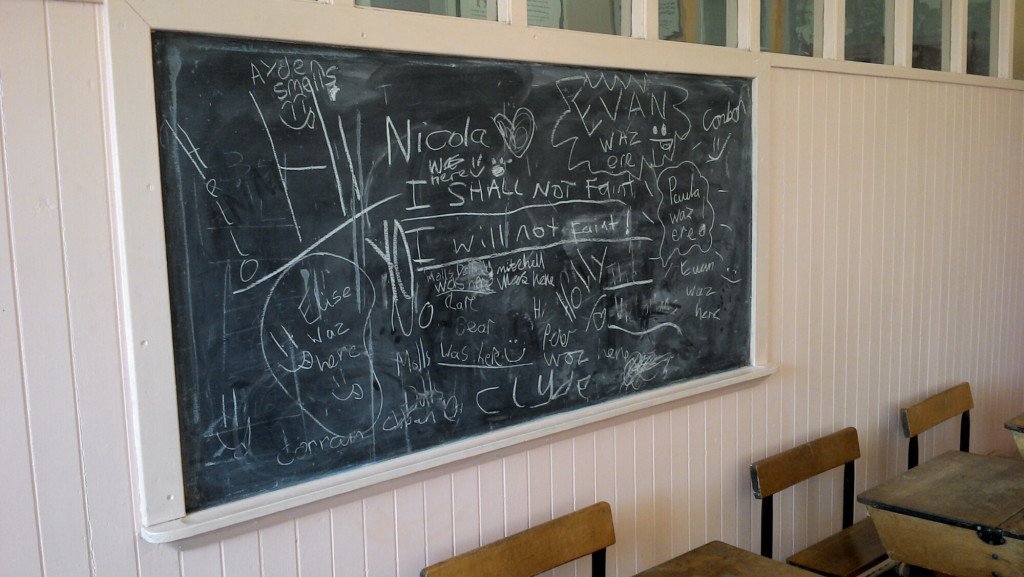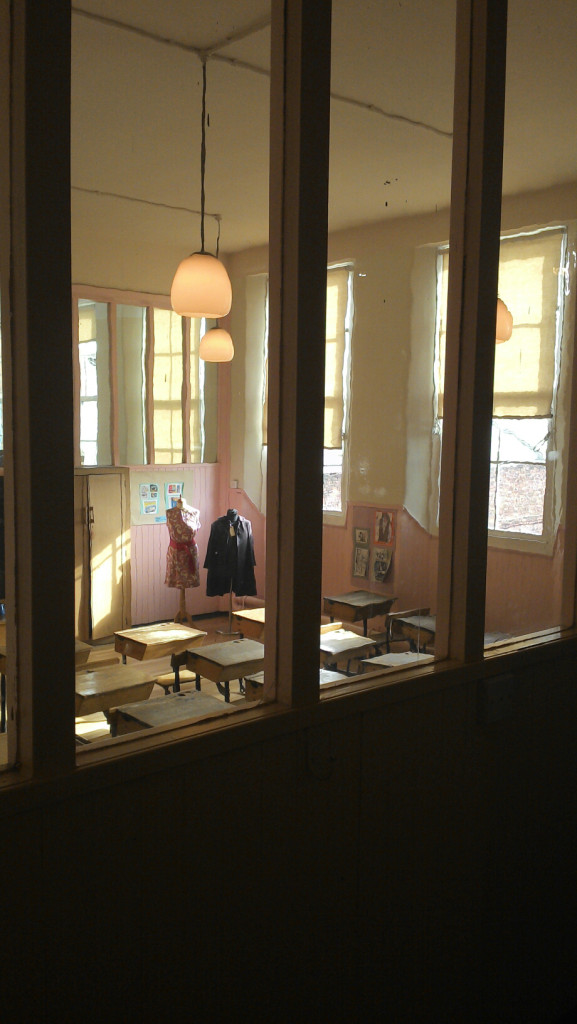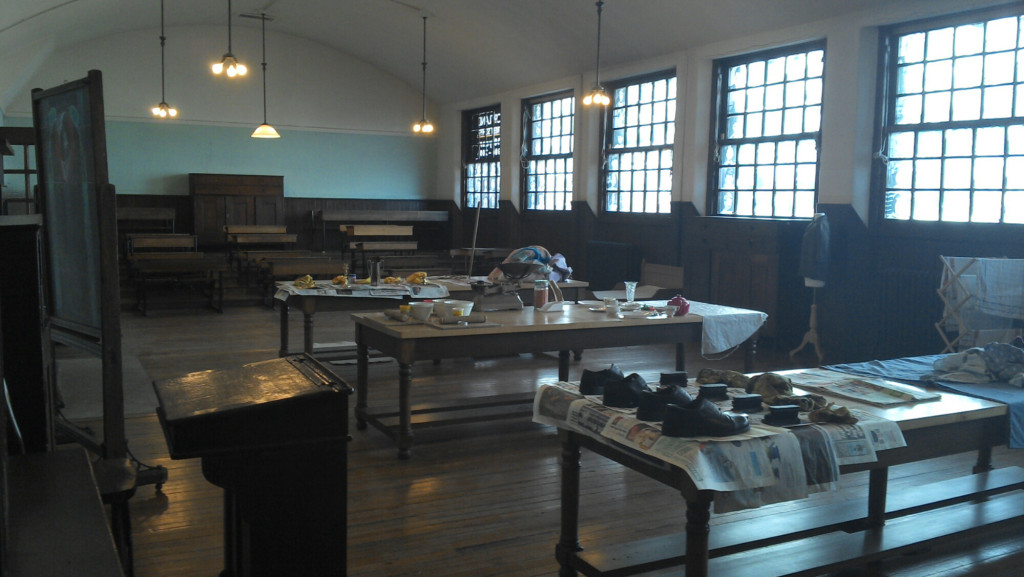Comics creator Lydia Wysocki recently blogged about the Comics Unconference in Glasgow on 28th February 2015, what reads like a fascinating day devoted to Comic Studies, including developements in digital comics, and has kindly permitted us to repost her report here. It features photos from her trip to Scotland Street School Museum the day after, because learning and that…
The Unconference started with a big paper and post it notes brain dump of what people wanted to talk about, then hands up voting to decide which topics were most popular so would be in the first two parallel sessions.
Unsurprisingly, I went for the ‘comics & education’ session. Damon Herd and Naomi Jacobs were facilitating. They asked if anyone wanted to start off with a presentation, so I did. I reused my Graphic Medicine (Baltimore 2014) slides about Asteroid Belter, skipping through to focus on examples of what comics creators and scientists got out of their collaborations. SPOILER: they both learned from each other.
[To the people who asked for my slides: I’m going to do a narrated version, the slides themselves aren’t the full presentation] Discussion then meandered: it wasn’t a Q&A about this one project, it became more of a discussion, which I liked.
There were good points well made about:
- how research communication and public engagement outputs can also be teaching resources
- how the cost of comics is prohibitive in comparison to publishers’ deals for 30 copies of, say, Hamlet, making it hard to teach comics as literature in schools
- WorldComicsIndia.com‘s ABCD Any Body Can Draw approach to encouraging people to make comics, especially 4-panel comics (start, middle, middle, end).
Next, and again unsurprisingly, I went for the ‘autobiography and comics’ session. There was no one presentation to get us started, but a show of hands found that a lorra lorra people round the table made and/or read autobio comics. Then:
- Jef Lewis talked about her diary comics as a way of processing stuff
- Andrew Godfrey talked about the Graphic Medicine approach to performance and autobiography, and “the fallacy of impartial text”
- Hattie Kennedy was all up in the performance of identity as a comics creator, and whether readers of autobio comics tend to give these texts more of a chance than autobio prose
- This headed into a discussion of ‘torture porn’ literature written/ghostwritten by people who were abused or experienced other bad things, ghostwriting more generally
- Then on to the importance of autobio comics being created in the moment not later, whether to help the creator process events or as a record made whilst doing/travelling/being – not as perfect drawing board or Photoshop’d drawings later.
It was only at the end that we talked about different sorts of autobio and examples of wholly or partially fictional stories presented as autobio or through barely-fictionalised avatars (it’s not me, it’s this guy). It was a shame that this session was on at the same time as the ‘zines’ session as there’s potential for a lot of shared ground, but the magic of Twitter #comicsunconf15 helped keep in touch with the other room.
In the first afternoon session I like totally broadened my horizons by going to the ‘digital comics’ session. There’s a possibility of digital comics projects through Applied Comics Etc in the not too distant future – no offense to the ‘comics and health’ panel, but all my Graphic Medicine-related experience went into the ‘comics and education’ session.
The digital comics session started with an awesome presentation by David Sweeney from Glasgow School of Art:
- we’ve had scanned comics (print first then digital), now on to digital first comics (then maybe collected in print) and digital native comics (designed specifically for online reading)
- Comixology’s ‘guides view’ feature controls how much of the comics page the reader sees on screen at any given time. Sometimes this works (Batman 2.0 was made with this in mind) sometimes not (Watchmen’s glorious page layouts are unsatisfying when seen one panel at a time); Margaret Mackey 2007 wrote about the importance of the stability of the page for reading (like, the page as a unit, not about reading on a bumpy Metro^)
- this addition of the Comixology guided view adds another layer to who is involved in making and reading comics. Sweeney showed how Walter Benjamin’s 1936 work The Work of Art in the Age of Mechanical Reproduction and Steven Shapiro’s 1997 Doom Patrols: A Theoretical Fiction About Postmodernism can help understand how that works
- Thrillbent/Insufferable won’t let their comics be read on Comixology guided view. They have other ways of deciding when panels are/not visible to the reader
- some talk of comics by Emily Carrol and how they use web technology
- apparently Philip K Dick predicted the emergence of motion (moving) comics, reckoning these would be the lowest form of entertainment
- Homestuck is a digital native comic that makes use of hyperlinks, browser features, Flash, and other web stuff
- visual novel games are big in Japan, there’s one about pigeon dating, and they’re sort of comics and choose-your-own-adventure stories combined
- there’s research at Glasgow School of Art into comics and Oculus Rift and other virtual reality technology.
Next session was ‘how comics work’, a narrow call between that an ‘WTF is Comics Studies?’. This turned out to be mostly about structure in comics:
- ‘Gasoline Alley’ as an example of using the whole page for one image, with panels and narrative embedded within this
- brief mention of comics designed to be read in different sequences, or no set sequence: Daniel Merlin Goodbrey, Chris Ware, Karen Rubins
- Woodrow Phoenix’s work: Rumblestrip with no human characters and lots of text, well-received by non comics readers; She Lives as a physically not and heavy comic read in groups, no text, the page turner might answer questions but is otherwise silent – different and similar to school carpet reading time/Jackanory
- this one time, Marvel and DC comics banned the use of thought bubbles. We (and Roger Sabin) think the use of speech bubbles has been around since long long ago, then became increasingly prevalent in 20th Century comics
- we found Google images of what looks like an EXPO building in the shape of speech bubbles with Chinese text projected (?) onto them (alas, only a mock up)
- Eddie Campbell has lamented that so few comics now start with a speech bubble outside a window, as it can be an effective way to draw readers in to the story with suspense over who said what
- Dieter Roth’s 1998 video installation Solo Scenes presented a series of short videos of him bumbling about his art studio, shown as a panel-type grid on a video wall. Sometimes he disappears from one panel to appear in another
- Grayson Perry’s work The Vanity Of Small Differences, drawing on Hogarth and history paintings and political cartooning traditions
- an art exhibition (Dave McKean’s The Rut) which included a mask to look through, with the eye line leading the viewer to the next artwork: sequential art without being comics?
- some awesome comics graffiti from ancient Pompeii (two figures captioned ‘I wish I were kissing someone else’) and art from early Mexico with coloured lines representing that talking is happening without saying what the words are.
The fourth session was a non-parallel session on ‘diversity?’. The question mark reflect the morning planning session’s discussion on whether we needed a session on diversity (race, gender, age, sexuality, dis/ability…) as much of this would come up on other sessions. The decision was that if we were discussing whether we needed it, we needed it.
The session began with a presentation from Kelly Kanayama on examples of stereotyped Asian and African female characters in comics (mostly superhero comics, 1950s+). There were many. Ari Silverman then told us about Diversity Crosscheck, a service on Tumblr where comics creators wanting to write about specific diversity issues can reach out to volunteers for advice based on their experiences.
I was frustrated that the discussion didn’t really move beyond a frame of reference of (old) mainstream comics, as this isn’t my field of comics knowledge. Maybe I was spoilt by the earlier education and autobio sessions, but in fairness the digital comics session did cover a wider range of comics. It was also a shame that only a small number of people were involved in this ‘diversity?’ discussion: too many people for a group discussion? a case for more intervention from moderators? an opportunity in future to agree areas of discussion at the start of the session, not to deny free-flowing discussion but to make sure the discussion is as inclusive as possible?
The final session was DEECAP, Dundee Comic Art Performance. This was fun and silly and worthwhile. There’s data projection of a comic and the creator of said comic talks/sings/acts/raps along with it. Damon Herd did stuff about teabags and guising, Andrew Godfrey made Damon into a taxi driver, David Robertson was Fred Egg Comics. M Contraband Esquire (aka Hope) rapped about copyright law, Kat Lombard Cook did a comic, and Paddy Johnson played guitar. I didn’t entirely know what to make of it all but I kinda liked it.
That, for me, is true of this Comics Unconference overall. I think it was a welcoming event, and worthwhile. I found it different to academic conferences in the following ways:
- the people. A good number of familiar faces from Comics Forum and Graphic Medicine, and a number of first-time-scholarly-comics-eventers. The teachers and student teachers contributed a lot to discussions
- the reference points. I was slightly longing for heavy-duty conference presentations that set out people’s theoretical approaches and research methods. Some of this is undoubtedly because I’m in the very early days of my PhD. Some of it’s because comics studies is such an interdisciplinary field that I need to know more about people’s approaches before really understanding their work. Without this I found that whilst some discussions went well others felt patchy
- the structure. Sessions that started with presentations – not as monologues, but as jumping off points for discussion – seemed to have a stronger start than discussion-only sessions. Sessions with strong moderators seemed to get most people in the group talking together. I missed abstracts as a way of having a better idea what to expect from a session.
All this is of course my take on an inherently collaborative event and was of course balanced by the immense value of spending a day talking withpeople about comics. I think the day length was about right. I’m glad I went – thanks, Comics Unconference 2015!
Lydia Wysocki is an educator, artist, editor, publisher and founder of Applied Comics Etc. All that wouldn’t fit on her business card, so it says Comics Boss.
Lydia has extensive experience of teaching, development, and public engagement in Higher Education in the UK, USA, and China. She has also worked in social and market research, as a retail buyer, and as the voice of English language textbooks. Lydia is doing a part-time PhD in Education, focussing on comics, and is a Senior Fellow of the Higher Education Academy.
• For more about Lydia’s artistic practice in comics, drawing, and printmaking, visit her website
Applied Comics Etc. is building on the Newcastle Science Comics project Lydia led with a team of seven editors. ACE continues to work as a team.
• For a list of Applied Comics Etc presentations and publications about comics, click here
The founder of downthetubes, which he established in 1998. John works as a comics and magazine editor, writer, and on promotional work for the Lakes International Comic Art Festival. He is currently editor of Star Trek Explorer, published by Titan – his third tour of duty on the title originally titled Star Trek Magazine.
Working in British comics publishing since the 1980s, his credits include editor of titles such as Doctor Who Magazine, Babylon 5 Magazine, and more. He also edited the comics anthology STRIP Magazine and edited several audio comics for ROK Comics. He has also edited several comic collections, including volumes of “Charley’s War” and “Dan Dare”.
He’s the writer of “Pilgrim: Secrets and Lies” for B7 Comics; “Crucible”, a creator-owned project with 2000AD artist Smuzz; and “Death Duty” and “Skow Dogs” with Dave Hailwood.
Categories: Comics Education News, Creating Comics, Digital Comics, Features








